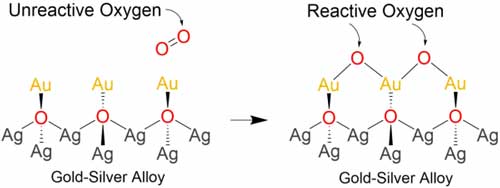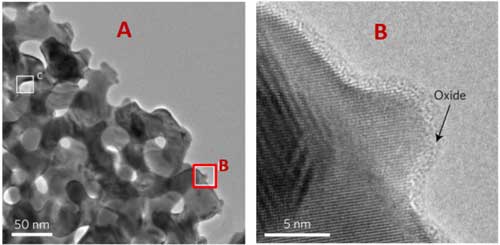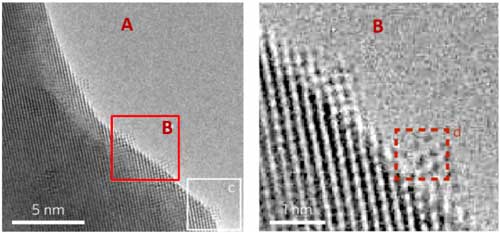| Posted: May 02, 2017 |
Fight to the top: Silver and gold compete for the surface of a bimetallic solid
(Nanowerk News) It’s the classic plot of a buddy movie. Two struggling bodies team up to drive the plot and do good together. That same idea, when it comes to metals, could help scientists solve a big problem: the amount of energy consumed by making chemicals.
|
|
Before delving into the intricacies of the chemistry in question, an introduction to alloys and their uses is beneficial. An alloy is a mixture of metals that often has properties superior to the sum of its parts.
|
 |
| Silver atoms migrate in an alloy, changing the material’s structure and reactivity as they do so. Understanding the changes is key to creating more energy-efficient catalysts. (Image: Nathan Johnson, Pacific Northwest National Lab)
|
|
For example, stainless steel is an alloy of mostly iron and chromium, and the mixture has the strength of iron and the corrosion resistance of chromium, yielding a symbiotic solid solution.
|
|
Alloys are commonly used as catalysts to accelerate a chemical reaction to form valuable products.
|
|
The transformation of methanol (CH3OH) to methyl formate (C2H4O2) is important for industrial production of chemicals critical to modern life, such as formamides and formic acid, which are precursors to pharmaceuticals and agricultural herbicides and pesticides. These chemicals are produced on such a large scale that improvement in reaction efficiency would result in significant energy savings and reduced environmental impact.
|
 |
| An alloy surface forms reactive oxygen. (Au): Gold, (Ag): Silver, (O): Oxygen. (Image: Nicholas Gould, CCEI EFRC)
|
|
However, the reaction is tricky. Oxygen in the air we breathe cannot react with methanol to create formate, because it exists as a pair of oxygen atoms. But most metal surfaces can break oxygen-oxygen bonds to form oxygen atoms that are reactive, the exception being pure gold.
|
|
Yet a gold-silver alloy has unusual properties, including creation of gold-oxygen bonds that pure gold cannot form. This is a similar phenomenon to formation of rust on iron surfaces, where rust is simply iron-oxygen bonds.
|
|
Recently, researchers at the Integrated Mesoscale Architectures for Sustainable Catalysis, an Energy Frontier Research Center, investigated a gold-and-silver alloy for turning methanol into methyl formate (Nature Materials, "Dynamic Restructuring Drives Catalytic Activity on Nanoporous Gold-Silver Alloy Catalysts").
|
 |
| (A) Low-magnification image of the alloy during ozone treatment. (B) Increased magnification image of an oxygen-rich layer formed during ozone treatment. (Image: Nicholas Gould, CCEI EFRC)
|
|
The material is highly porous, which gives it a high contact area with any gases flowing through it. However, the material has surprisingly dynamic properties, and as the alloy is exposed to different gas streams, the positions of gold and silver atoms rearrange. Some arrangements led to the desired methyl formate, while others led to valueless carbon dioxide.
|
|
The challenge is to understand how the alloy restructures during the reaction, and how to maintain the desired configuration. Initially, the catalyst had to be treated with gaseous flowing ozone, O3 (three oxygens bonded together), to form the desired structure.
|
|
The team examined the alloy using high-resolution microscopy at Brookhaven National Laboratory and X-ray photoelectron spectroscopy at Lawrence Berkeley National Laboratory. By looking closely and probing only the first few layers of the material, the team identified the structure responsible for methyl formate production.
|
|
They discovered that silver-and-gold alloys, enriched in silver (greater than the overall 3 percent), catalyze methanol conversion to methyl formate. During ozone treatment, the silver atoms are enriched on the surface. In other words, silver atoms inside the metal alloy reacted with ozone and migrated towards the surface to form silver-oxygen and gold-oxygen bonds.
|
 |
| (A) Low-magnification image of the alloy shortly after methanol treatment. (B) Increased magnification image of the removal of the oxygen-rich surface in the previous figure (right), and the formation of gold-rich particles (red square). (Image: Nicholas Gould, CCEI EFRC)
|
|
When the feed is switched from ozone to methanol, the methanol reacts with the surface oxygen. Initially, the methanol reacts to carbon dioxide, but after the surface oxygen is depleted, the methanol converts to valuable methyl formate. Surprisingly, as the oxygen is consumed, silver migrates into the subsurface — a few layers of atoms below the surface — forming a local surface alloy. This structural change coincided with the formation of a new oxygen species and the production of methyl formate. Thus, at this point, the alloy was in an optimal structure to create methyl formate.
|
|
However, further exposure to methanol removed the oxygen responsible for methyl formate production and caused further, detrimental rearrangements of the silver and gold atoms. Fortunately, the team found that supplementing the methanol feed with oxygen allowed for the continual regeneration of the valuable oxygen species responsible for formate production. Thus, a key factor for maintaining the methyl formate production is to keep the subsurface silver alloy structure from rearranging. The team prevented the alloy from restructuring by using the right operating temperature and oxygen content in the methanol stream.
|
|
The novelty of this work lies in its observations of the catalyst behavior during the reaction. The work demonstrates the dynamic nature of the catalyst and shows that the products are sensitive to the catalyst structure. The knowledge of how catalysts restructure during the reaction will lead to using the proper conditions and, ultimately, lower costs and environmental impact for commodity chemical production.
|




